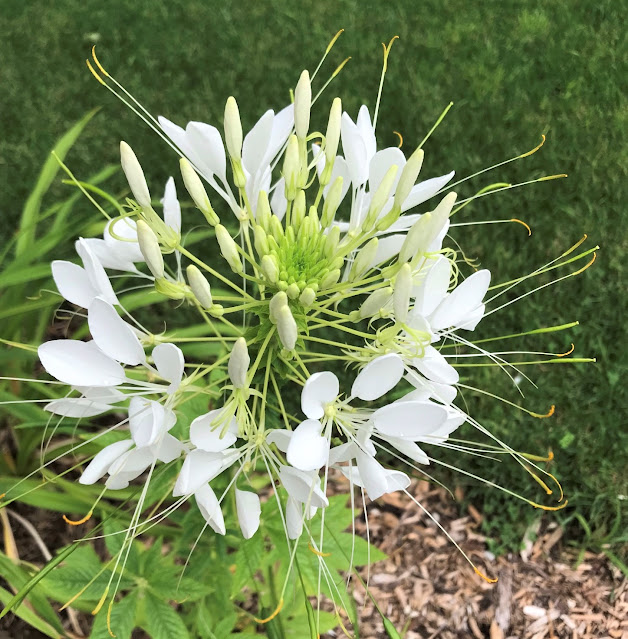Mrs. F.G. has always chosen plants to favour pollinators, from butterflies down to tiny bees. We feel she's been quite successful as there are always bugs of various sorts buzzing around the garden. That gave her the idea that I should do a post on stamens and pistils, which are of course critical to the flowers reproduction and entirely dependent on pollinators.
Pistils and stamens are usually easy to see, as are pollinators. You can clearly see the single longer pistil in these Hosta flowers,, and several slightly shorter stamens that carry the pollen.
This Day Lily flower is an excellent example and easy to see. The single tall white stem is the pistil and the three visible shorter stems are the stamens, with the pollen held at the top.
It was the Cleome flowers that first struck Mrs. F.G. Look at how far out the pistils and stamens reach. Even here you can probably see the difference between stamens (with pollen) and pistils (without).
There is only one pistil totally visible here, at the top, looking mostly greenish and longer than the pollen-holding stamens. The pollen on some stamens here simply has not matured yet.
On this Agapanthus the stigma, the end part of the pistil, is held horizontally while the stamens are held vertically, all slightly brown against the blue flower.










Beautiful shots!
ReplyDeleteGreat post, fabulous photographs.
ReplyDeleteAll the best Jan
The second picture is my favorite - so crisp and clear, though all are beautiful!!
ReplyDeleteNature and your explanation gives us an insight into the miracles of plant life. Lovely deep shades in all those petals, and the pollen on lilies can be so hard to remove from fingers, a white tablecloth or even the carpet if it drops down. Then in come the bees to work more magic.
ReplyDeleteLovely shots! Botany was one of most enjoyable courses that I took at university maybe because the prof was really good. The bees all seem to really like the flowers on my oregano when I let it go to seed.
ReplyDeleteMy thyme is just loaded with pollinators. When it jumped the bed and took over that part of the lawn, I let it go wild. The bugs love it. Tomorrow I'm going to lay on the ground and have a good hard look at what they find so attractive in those minuscule blossoms.
ReplyDeleteI think I recall first learning about pistils and stamens back in public school. Of course I have forgot everything I learned back in those days but your post shook up some of my cranium dust and I had a few memory flashbacks.
ReplyDeleteIt's amazing how many answers nature has come up with to solve the same problem, relying on different insects and even the wind. I learned recently that some flowers like foxgloves have a special non-slip area on the lower petal to allow bees to land without slipping off! Your close-up photos are splendid.
ReplyDeleteYou must have rolled your eyes and shaken your head when I called stamens pistils on my post. :)
ReplyDeleteI recall teaching about stamens and pistils with some curriculum. That's what I always think of when I read the two words. I loved teaching the kids new vocabulary.
ReplyDeleteThank you! I learned a lot in this post. I'll be checking out my own nearby flowers now. :-)
ReplyDeletePistils and stamens, great idea for a post. I learned all about them as a young girl in school and haven't thought of them much since. Thank you for the reminder lesson. ;)
ReplyDeleteI like the Zinnia pistils and stamens, very tiny but plentiful. 😍
Nice display of the reproductive parts of your garden flowers. H's stepfather, who was a tremendous gardener, warned us about having cleome in the garden due to its propensity to spread. We have a Rudbeckia that attracts tremendous numbers of small bees to the garden.
ReplyDeleteGreat photos! I appreciate the work the bees and the bugs do for us, and always ensure there is a source of water for them nearby. I belong to a gardening group on FB and I read of people hand pollinating their tomatoes and such. I've never felt the need as nature takes care of it for me.
ReplyDeleteI can't get my agapanthus to bloom. I learned a lot today about those things that stick out of the flowers. I now have the correct names.
ReplyDeletesuch gorgeous and colorful blooms!!
ReplyDeleteMy yard is now filled with pollinators. I need to put up traffic lights to cross my driveway!
ReplyDeleteNice post with great photos!!
ReplyDelete